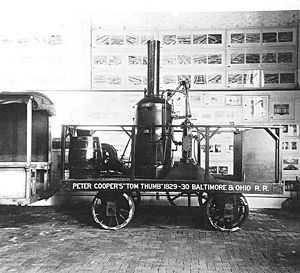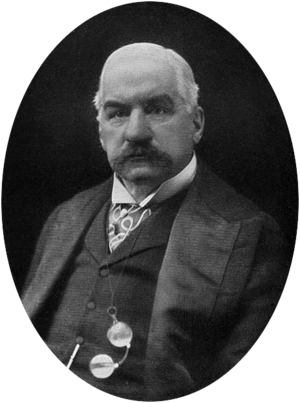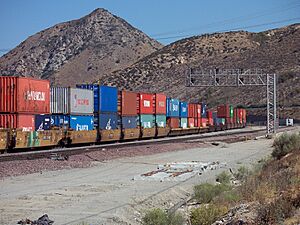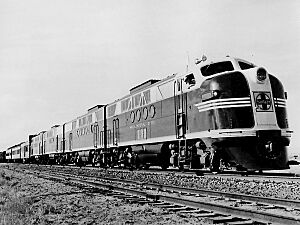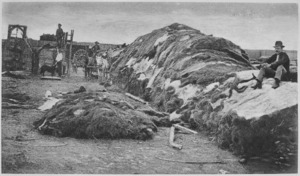History of rail transportation in the United States facts for kids
- This article is part of the history of rail transport by country series.
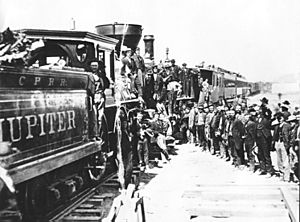
Railroads have played a huge part in shaping the United States! From the early 1700s, simple wooden tracks called wagonways were used. One of the first was built in 1720 for a French fort in what is now Canada. Later, around 1762-1764, British engineers built a special "gravity railroad" near Niagara River to help move things up a steep hill.
These early tracks grew into a massive network that helped the U.S. develop, especially during the Industrial Revolution. The first passenger and freight line, the Baltimore and Ohio Railroad (B&O), started in 1827. For the next 45 years, railroads expanded rapidly, connecting cities and towns across the country.
Before the American Civil War (1861–1865), the northern and midwestern states built strong rail networks. This helped farmers send their crops and animals to markets far away. In the South, railroads were mostly short lines connecting farms to ports, which became a problem during the war.
By 1910, most of the major rail lines were built. But then, new ways to travel and transport goods appeared, like trucks, cars, and airplanes. This meant fewer people traveled by train. After 1940, new diesel locomotives made trains much more efficient, needing fewer workers.
Today, most long-distance passenger travel is handled by Amtrak, a government-owned company. Freight railroads are still very important for the U.S. economy, moving large amounts of goods like coal, oil, and shipping containers. In fact, American freight railroads are known as some of the best in the world!
Contents
How Railroads Started (1720–1860)
Early Tracks and First Trains
The very first railroads in North America were simple wooden tracks. As mentioned, one was used in 1720 to build a French fort in Louisburg, Nova Scotia. Later, a "gravity railroad" was built near the Niagara River in New York around 1762. It helped move supplies up a steep hill. The local Seneca people called this area "Crawl on All Fours."
In 1810, the Leiper Railroad in Pennsylvania became one of the first permanent railroads. It used animals to pull cars and helped move stone. It was later used again in 1852 and eventually became part of a larger railroad system.
In 1826, the Granite Railway in Massachusetts started. It mainly hauled granite for building the Bunker Hill Monument. Parts of this railway were still used until the 1940s!
Many states soon started building their own railroads. Maryland chartered the Baltimore and Ohio Railroad (B&O) in 1827 to connect Baltimore to the Ohio River. The B&O was the first railroad to carry both passengers and freight. At first, horses pulled the train cars!
Steam Power Arrives
The South Carolina Canal and Rail Road Company was the first to regularly use steam locomotives, starting in December 1830 with the "Best Friend of Charleston." This was the first American-built locomotive made for regular service.
The B&O also developed its own steam locomotives. In 1829, Peter Cooper built the "Tom Thumb." It was the first American-built locomotive to run in the U.S., showing everyone how powerful steam could be. Many early locomotives came from England, but soon, American companies started building their own.
By 1850, the U.S. had about 9,000 miles (14,000 km) of railroad lines. The government helped build more by giving land to new railway companies in the West. This land could be sold to help fund the railroads. This program helped open up many western lines, including the famous Union Pacific-Central Pacific route.
Trains Change Travel and Trade
Railroads quickly became better than canals and steamboats. Trains could run all year, even in winter when canals froze. They were also safer and faster. This meant businesses could keep less inventory and save money on storage and insurance.
Travel also changed for people. Before trains, most people traveled by horse or bumpy stagecoach. Trains offered a smoother, more comfortable ride with more space. Some fancy passenger trains even had dining cars and sleeping rooms!
By 1860, railroads in the North and Midwest connected almost every major city. In farming areas, over 80% of farms were within 5 miles (8 km) of a railway. Many small lines were built, but over time, they joined together into larger "trunk lines."
War, Growth, and Challenges (1861–1916)
Railroads During the Civil War
Railroads were very important during the American Civil War. The North had a much larger and better rail system, which helped them move soldiers and supplies more effectively. Most factories that made rails and equipment were in the North.
In the South, many railroads were local and connected cotton farms to rivers or ports. When the North blocked Southern ports and took control of key rivers, long-distance travel became very hard. Southern railroads struggled because they couldn't get new equipment or spare parts. Both sides also destroyed enemy bridges and tracks to slow them down. By 1864–65, the Southern rail network had almost completely broken down.
Connecting the Coasts
After the war, in 1862 and 1863, new laws helped build the first Transcontinental Railroad. With money from the government and hard work from Chinese and Irish laborers, the Central Pacific Railroad (building from the West) and the Union Pacific Railroad (building from the East) met in 1869. This amazing achievement linked the eastern states with the Pacific coast! You could now travel from New York City to San Francisco Bay in just six days.
More transcontinental railroads were built, helping people move West and bringing goods like cattle, wheat, and minerals back East. By 1890, railroads carried five times more freight than waterways.
Rebuilding the South and Labor Issues
After the war, Northern money helped rebuild and expand railroads in the South. They were modernized and changed to a "standard gauge" (track width) in just two days in May 1886. This helped connect the South to the rest of the country.
However, the rapid growth wasn't always smooth. The "Panic of 1873" was a major economic downturn that caused many railroads to go bankrupt. Workers were laid off or had their wages cut. This led to big strikes, like the Great Railroad Strike of 1877, where workers protested against wage cuts. The government had to send in troops to stop the violence.
Big Business and Regulation
By 1880, the U.S. had a huge railroad industry, employing more people than any other sector outside of farming. Railroads helped open up vast amounts of farmland, lowered costs for goods, and created a huge national market.
Powerful businessmen like J. P. Morgan, Cornelius Vanderbilt, and Jay Gould became very rich by owning railroads. They often combined smaller lines into huge companies. To prevent these companies from becoming too powerful and unfair, Congress passed the Interstate Commerce Act of 1887. This law created the Interstate Commerce Commission (ICC) to oversee railroads and make sure they followed fair rules.
Another economic downturn, the "Panic of 1893," caused many more railroads to fail. This led to even more consolidation, with a few large companies controlling most of the rail lines by 1906. The government also passed "antitrust" laws to prevent monopolies.
In 1904, President Theodore Roosevelt broke up the Northern Securities Company, a large railroad combination, to ensure fair competition. The ICC gained more power to set maximum rates for railroads in 1906. By 1916, U.S. railroads reached their longest length of tracks ever, with over 254,000 miles (408,000 km).
Modern Railroads (1917–Present)
World Wars and New Challenges
During World War I, the government temporarily took over managing the railroads from 1917 to 1920. This helped coordinate freight traffic and standardize equipment for the war effort.
After the war, in the 1920s, there were ideas to combine many railroad companies into a few large systems to make them more efficient. However, these plans never happened. Many smaller railroads struggled and failed during the Great Depression in the 1930s.
After World War II, railroads faced tough competition from airlines and the growing Interstate Highway System. Cars and trucks became very popular, leading to the end of passenger train service on most railroads. Trains continued to carry heavy goods like coal and steel.
Government Help and Changes
In 1966, the Federal Railroad Administration (FRA) was created to set and enforce rail safety rules.
By the late 1960s, many major railroads were struggling. Two of the largest, the Pennsylvania Railroad and the New York Central, merged to form Penn Central in 1968, but it went bankrupt in 1970. This was the largest bankruptcy in U.S. history at the time.
To save passenger rail service, Congress created Amtrak in 1970. Amtrak took over most inter-city passenger trains from private railroads in 1971.
To help struggling freight railroads in the Northeast, Congress created the Consolidated Rail Corporation (Conrail) in 1973. Conrail was a government-owned company that took over freight operations from bankrupt lines. Amtrak also bought most of the tracks along the busy Northeast Corridor from Washington, D.C. to Boston.
Freight Railroads Bounce Back
In 1980, Congress passed the Staggers Rail Act. This law removed many old rules, allowing freight railroads to compete better with trucks. Railroad companies could now set their own rates and drop unprofitable routes. This led to more mergers and consolidations, creating fewer but much more profitable large "Class I" railroads that cover huge regions of the U.S.
Since then, major railroads like Union Pacific, CSX, BNSF Railway, and Norfolk Southern have grown through mergers. In 1995, the ICC, which had regulated railroads for so long, was finally abolished, and its remaining duties went to the new Surface Transportation Board.
In the 21st century, railroads and the government have been investing in new projects to improve freight transport, like building new terminals and improving bridges and tunnels. There have also been plans for new high-speed rail lines, like the one being built in California, though these projects often face delays and cost increases.
How Railroads Work (Technology)
Building Rails and Tracks
Early American railroads often imported technology from Britain, especially iron rails. The first heavy iron "T" rails were made in the U.S. in the 1840s. This new design allowed trains to go faster and run more reliably. Later, in the late 1800s, steel rails began to replace iron ones, making tracks even stronger.
Track Sizes
In the early days, different railroads used different track widths, or "gauges." This made it hard for trains to travel from one line to another. Great Britain had a "standard gauge," and the U.S. eventually adopted it. The first transcontinental railroad was built using this standard gauge. After the Civil War, most tracks across North America were standardized, making it much easier for trains to travel long distances.
Locomotives: From Steam to Diesel
At first, American railroads imported many steam locomotives from England. Soon, American companies like Norris, Baldwin, and Rogers started building their own.
Diesel locomotives were developed in Europe after World War I. U.S. railroads started using them widely in the 1930s and 1940s. Diesel engines were expensive to build but were easier to maintain and needed only one person to operate, saving money and making trains more reliable. By the 1950s, most U.S. railroads stopped using steam locomotives.
While electric trains became popular in Europe, they were less common in North America. Today, most freight trains in the U.S. are pulled by diesel locomotives, though the busy Northeast Corridor passenger line uses electric trains.
Signals and Communication
Early railroads had very basic ways to manage trains. They used timetables, but there was no way for drivers and dispatchers to talk to each other. This sometimes led to crashes!
When the telegraph arrived in the 1840s, a better system was developed. Train "orders" could be sent by telegraph to change timetables, allowing trains to be canceled, rescheduled, or added.
In the 1870s, new technology like "track circuits" led to "block signals." These signals divided the track into sections, making trains safer and more efficient. Mechanical "interlockings" were also introduced to prevent trains from colliding at junctions. Today, electronic systems are used for even better safety.
People and Safety
Working on the Railroad
Railroads changed how companies managed their employees. With thousands of workers, railroads created clear rules for hiring, promoting, paying, and supervising staff. This new way of managing large groups of people was later copied by many other big businesses.
Working on the railroad became a lifelong career for many young men. They could start working on the tracks, then become a fireman, and eventually an engineer. Office jobs also offered career paths, with young men starting in clerical work and moving up to station agents or managers. Railroads were among the first companies to offer pensions to their employees, encouraging them to stay.
Making Work Safer
As railroads grew, so did the number of accidents, especially for brakemen who had dangerous jobs coupling cars and operating hand brakes. By the 1880s, railroad work was almost as dangerous as coal mining.
People started demanding safety laws. In 1893, Congress passed the Railroad Safety Appliance Act. This law required railroads to install air brakes and "automatic couplers" on all trains. This led to a huge drop in accidents, making rail work much safer.
Later, in 1970, the Federal Railroad Safety Act gave the FRA broad power to oversee all aspects of rail safety for every railroad in the country.
Railroads' Big Impact
Railroads completely changed the American economy and society in many ways.
Moving Goods and People
First, railroads created a super-efficient way to ship goods and people across the country. This transformed almost every part of the economy, from factories to farms. With the telegraph for fast communication, the U.S. now had a huge national market, like a giant shopping mall without any internal borders or taxes. Railroads replaced older ways of transport like canals and steamboats.
Funding the Nation's Growth
Building railroads was very expensive, much more so than building factories or canals. By 1897, the total value of railroad stocks and bonds was over $10 billion! This money came from investors across the U.S. and from Europe, especially Britain. The government also helped by giving land to Western railroads, which they could sell to farmers to fund construction. This helped create new towns and customers along the rail lines. The financial system in America grew largely because of railroad bonds.
Inventing Modern Management
Railroads also invented new ways to manage large, complex businesses. Early railroads like the Baltimore and Ohio and the Pennsylvania Railroad developed systems to track train movements, manage finances, and keep costs low. They divided their systems into different sections, with managers reporting daily to a central office. This "bureaucracy" and systematic approach to management was so successful that other big businesses copied it.
Changing American Life
People were amazed by the size and efficiency of railroads. Cities worked hard to get a railroad line, knowing it would bring prosperity. People would dress up to go to the train station just to watch the trains arrive. Railroads became a symbol of American progress and unity.
Travel became much easier and cheaper. People from small towns could take day trips to big cities. Hotels and tourist spots grew to meet the demand. Being able to buy a ticket for a thousand-mile trip was a powerful new freedom. This helped create a stronger sense of national identity.
However, not everyone loved railroads. Some worried they would spoil the natural landscape. Farmers in the West complained that railroads had too much power and charged unfair prices. This led to laws being passed to regulate railroad rates. After 1910, railroads also faced new competition from trucks, cars, and buses.
Railroads and Nature
Railroads also had a big impact on the environment. They made it possible to transport goods and people much faster and further than before. This meant that natural resources, crops, and even animals could be moved across vast distances.
Impact on Buffalo
Before the Civil War, millions of buffalo roamed the Midwest. But after the war, their numbers dropped dramatically. Why? Because their hides became very valuable. William Temple Hornaday, a famous zoologist, said that "as soon as the railways crossed the buffalo country, the slaughter began."
Railroads made it easy for hunters and businessmen to transport buffalo hides, meat, and bones to distant markets where they were in high demand. Before trains, it wasn't practical to commercialize buffalo hunting because it took too long to move the products. With railroads, people could make a lot of money from the seemingly endless buffalo herds. This led to such extreme hunting that wolves couldn't even eat all the leftover carcasses.
The rapid decline of the buffalo population also created new jobs, like hunting and skinning bison, and maintaining the railroad lines used to transport the hides.
Images for kids


